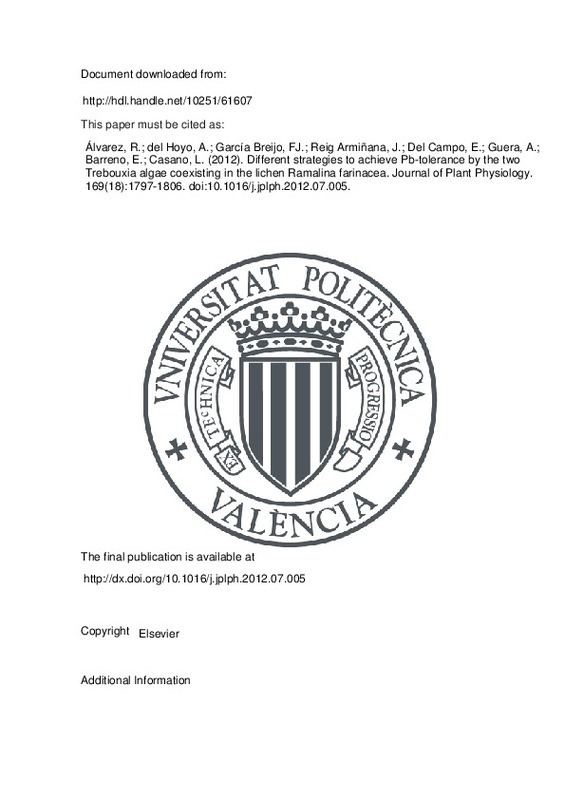JavaScript is disabled for your browser. Some features of this site may not work without it.
Buscar en RiuNet
Listar
Mi cuenta
Estadísticas
Ayuda RiuNet
Admin. UPV
Different strategies to achieve Pb-tolerance by the two Trebouxia algae coexisting in the lichen Ramalina farinacea
Mostrar el registro sencillo del ítem
Ficheros en el ítem
| dc.contributor.author | Álvarez, Raquel
|
es_ES |
| dc.contributor.author | Del Hoyo, Alicia
|
es_ES |
| dc.contributor.author | García Breijo, Francisco José
|
es_ES |
| dc.contributor.author | Reig Armiñana, José
|
es_ES |
| dc.contributor.author | del Campo, Eva María
|
es_ES |
| dc.contributor.author | Guéra, Alfredo
|
es_ES |
| dc.contributor.author | Barreno, Eva
|
es_ES |
| dc.contributor.author | Casano, Leonardo M.
|
es_ES |
| dc.date.accessioned | 2016-03-09T12:45:03Z | |
| dc.date.available | 2016-03-09T12:45:03Z | |
| dc.date.issued | 2012-11-01 | |
| dc.identifier.issn | 0176-1617 | |
| dc.identifier.uri | http://hdl.handle.net/10251/61607 | |
| dc.description.abstract | Lichen thalli are permeable to airborne substances, including heavy metals, which are harmful to cell metabolism. Ramalina farinacea shows a moderate tolerance to Pb. This lichen comprises two Trebouxia phycobionts, provisionally referred to as TR1 and TR9, with distinct physiological responses to acute oxidative stress. Thus, there is a more severe decay in photosynthesis and photosynthetic pigments in TR1 than in TR9. Similarly, under oxidative stress, antioxidant enzymes and HSP70 protein decrease in TR1 but increase in TR9. Since Pb toxicity is associated with increased ROS formation, we hypothesized greater Pb tolerance in this phycobiont. Accordingly, the aim of the present study was to characterize the physiological differences in the responses of TR1 and TR9 to Pb exposure. Liquid cultures of isolated phycobionts were incubated for 7 days in the presence of Pb(NO3)2. Thereafter, extracellular and intracellular Pb accumulation, photosynthetic pigments, and photosynthesis (as modulated chlorophyll fluorescence) were analyzed along with the antioxidant enzymes glutathione reductase (GR), superoxide dismutase (SOD), ascorbate peroxidase (APx), and catalase (CAT), and the stress-related protein HSP70. Pb uptake increased with the amount of supplied Pb in both algae. However, while significantly more metal was immobilized extracellularly by TR9, the amount of intracellular Pb accumulation was three times higher in TR1. In neither of the phycobionts were significant effects on photosynthetic pigments or photosynthetic electron transport observed. While under control conditions GR, SOD, and APx levels were significantly higher in TR1 than in TR9, only in the latter were these enzymes induced by Pb. This resulted in quantitatively similar antioxidant activities in the two algae when exposed to Pb. In conclusion, the phycobionts of R. farinacea make use of two different strategies against stress, in which the integration of distinct anatomical and physiological features affords similar levels of Pb tolerance. | es_ES |
| dc.description.sponsorship | This study was supported by the Spanish Ministry of Science and Innovation (CGL2009-13429-C02-01/02) and the Generalitat Valenciana (PROMETEO 174/2008 and GVACOMP2011-205). We are grateful to the Central Support Service in Experimental Research (SCSIE), University of Valencia (Spain), for the TEM studies. We acknowledge Dr. Said Agouram (SCSIE, University of Valencia, Spain) for TEM-EDXS characterizations and for helpful discussions during the TEM investigations. We thank Wendy Ran and Daniel Sheerin for the English revision of the manuscript. | en_EN |
| dc.language | Inglés | es_ES |
| dc.publisher | Elsevier | es_ES |
| dc.relation.ispartof | Journal of Plant Physiology | es_ES |
| dc.rights | Reserva de todos los derechos | es_ES |
| dc.subject | Heavy metal tolerance | es_ES |
| dc.subject | Lead | es_ES |
| dc.subject | Lichen microalgae | es_ES |
| dc.subject | Stress response | es_ES |
| dc.subject | Trebouxia algae | es_ES |
| dc.subject.classification | BOTANICA | es_ES |
| dc.subject.classification | BIOLOGIA VEGETAL | es_ES |
| dc.title | Different strategies to achieve Pb-tolerance by the two Trebouxia algae coexisting in the lichen Ramalina farinacea | es_ES |
| dc.type | Artículo | es_ES |
| dc.identifier.doi | 10.1016/j.jplph.2012.07.005 | |
| dc.relation.projectID | info:eu-repo/grantAgreement/MICINN//CGL2009-13429-C02-01/ | |
| dc.relation.projectID | info:eu-repo/grantAgreement/GVA//PROMETEO08%2F2008%2F174/ | |
| dc.relation.projectID | info:eu-repo/grantAgreement/GVA//ACOMP%2F2011%2F205/ | |
| dc.rights.accessRights | Abierto | es_ES |
| dc.contributor.affiliation | Universitat Politècnica de València. Departamento de Ecosistemas Agroforestales - Departament d'Ecosistemes Agroforestals | es_ES |
| dc.description.bibliographicCitation | Álvarez, R.; Del Hoyo, A.; García Breijo, FJ.; Reig Armiñana, J.; Del Campo, EM.; Guéra, A.; Barreno, E.... (2012). Different strategies to achieve Pb-tolerance by the two Trebouxia algae coexisting in the lichen Ramalina farinacea. Journal of Plant Physiology. 169(18):1797-1806. https://doi.org/10.1016/j.jplph.2012.07.005 | es_ES |
| dc.description.accrualMethod | S | es_ES |
| dc.relation.publisherversion | http://dx.doi.org/10.1016/j.jplph.2012.07.005 | es_ES |
| dc.description.upvformatpinicio | 1797 | es_ES |
| dc.description.upvformatpfin | 1806 | es_ES |
| dc.type.version | info:eu-repo/semantics/publishedVersion | es_ES |
| dc.description.volume | 169 | es_ES |
| dc.description.issue | 18 | es_ES |
| dc.relation.senia | 229592 | es_ES |
| dc.contributor.funder | Ministerio de Ciencia e Innovación | |
| dc.contributor.funder | Generalitat Valenciana |







![[Cerrado]](/themes/UPV/images/candado.png)

